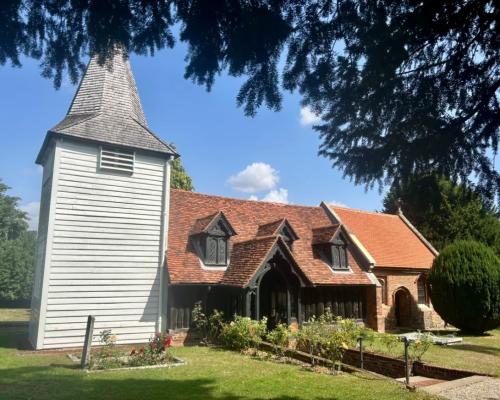
A sign in the layby boldly declares: “The world’s oldest wooden church, open today.” Just beyond, beneath an arching yew, is St Andrew’s Church in Greensted, its architecture a historical mosaic, a seemingly mismatched patchwork that forms a striking whole.
People have been worshipping here for at least 1,300 years. In the 1960s, archaeologists uncovered the impression of two wooden buildings, potentially built in the late sixth or early seventh century, when Christianity was taking root in the region. But it is the palisade nave that has earned the church its remarkable claim. A copse of 51 split oaks forms the central body of the church, constructed around 1060 during the reign of Edward the Confessor, and at one time adorned with nothing but a thatched roof.
An eag-thyrel, an eye hole, which allowed the priest to see outside activity – vital during the ninth-century Danish invasions – and a niche, potentially to hold holy water, would have cast the only thin beams of natural light across the soil floor. All other illumination would have been provided by lamps, torch marks scarring the timbers.
Over time, transformative restorations took place, giving it the patchwork look: flint remains indicate a chancel built by the Normans; the current brick one was built by the Tudors, along with a tiled roof. The Stuarts added the white tower in Essex clapboard style, while the Victorians rejuvenated rotting timbers and preserved the building for future generations. And the stories continue in the details: the beam etched with the face of Saint Edmund, king of East Anglia, whose body briefly rested here on route to Bury St Edmunds; the 12th-century crusader’s grave whose stone tomb hints at a heroic status; the 1839 entry in the marriage register of one of the Tolpuddle Martyrs, who held tenancies here before emigrating to Canada.
The church is still in use today; services are held every Sunday, as well as marriages and baptisms. While it and its grounds are beautiful, it is the oaks that capture the attention. Each is individual in size and character, time-weathered and aged to black. They have witnessed Viking raids, the decline of paganism, medieval pilgrimages, war, the Reformation and the plague. Centuries held in knot and burr, they remain rooted in Essex’s past and present.
• Under the Changing Skies: The Best of the Guardian’s Country Diary, 2018-2024 is published by Guardian Faber; order at guardianbookshop.com and get a 15% discount





